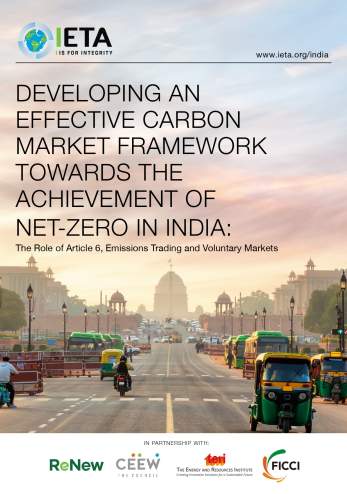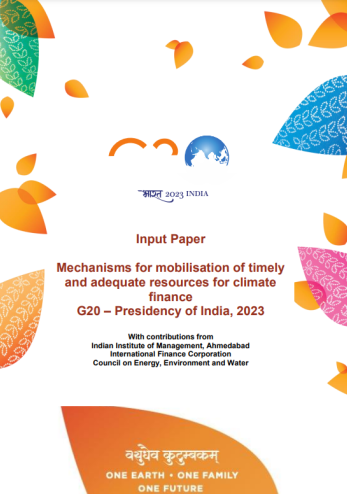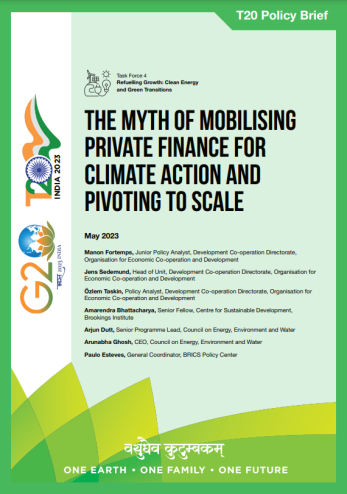Report
Coordinating Global Risk Mitigation for Exponential Climate Finance
Arunabha Ghosh and Nandini Harihar
October 2021 | Sustainable Finance
Suggested Citation: Ghosh, Arunabha, and Nandini Harihar. 2021. Coordinating Global Risk Mitigation for Exponential Climate Finance. A GCF-CEEW Report. Stockholm: Global Challenges Foundation.
Overview
The study provides an overview of gaps in international climate and clean energy finance and highlights the current status of financial initiatives in addressing the gaps. To ease the flow of capital, the study proposes a Global Clean Investment Risk Mitigation Mechanism (GCI-RMM), which works on the principle of risk pooling across projects and countries. The GCI-RMM would help to ease access to non-project risk management tools and reduce transaction costs, particularly in emerging markets. The study proposes coordination across four sets of actors to drive global multi-sectoral coordination, aggregate clean energy demand, provide financial de-risking services, and raise clarity and confidence of financiers and the private insurance industry.
Key Highlights
- The study highlights four key gaps in international climate and clean energy finance. This includes:
- Ambiguity in the definition of international climate and non-standardised accounting
- Limited volume of capital flows to developing countries
- Perceived risks exceeding real ones in emerging markets
- Limited private investment for international climate finance
- The study analyses 26 international initiatives on clean energy finance, initiated between 2011 and 2021, which are meant to bridge at least one (or more) of these four gaps. However, only one initiative developed a transparent principle to account for clean energy investments.
- There are a dozen initiatives catering to boost mitigation efforts in low-to-middle-income developing countries. But fund flows remain insufficient and have not increased substantially over time.
- There are nine initiatives that try to tackle investment risks.
- There are 19 initiatives that seek to unlock private capital, of which ten provide some funds as well.
- For 2021 to be a banner year for climate finance, four shifts relating to scale, regulation, balance, and risk are necessary.
- The broader shifts in climate finance face an overwhelming challenge, namely the lack of coordination among different categories of financial institutions.
Key Recommendations
- Establish a Global Clean Investment Risk Mitigation Mechanism (GCI-RMM).
- The GCI-RMM will work on the principle of risk pooling across projects and countries. It will:
- Ease access to non-project risk management tools and reduce transaction costs
- Optimise the availability of de-risking products
- Increase liquidity and portfolios diversity for insurance providers to reduce de-risking costs
- Trigger learning effects and promote innovation in the future
- Creation of a well-coordinated financial architecture is critical to facilitate a leapfrog to a cleaner energy future and build greater climate resilience in emerging economies.
- The GCI-RMM platform could coordinate across four sets of actors to regain trust in international climate efforts and build the necessary financial architecture. This includes:
- The role of the UK COP-26 Presidency to coordinate efforts between negotiating parties, key financial institutions, and strategic philanthropy seeking to scale climate finance.
- The role of large sources and destinations of institutional capital to help aggregate demand and projects across member countries. This would include coordination between countries like the US – a major source of international institutional investment –and India – an emerging economy, a major destination of clean investment and the host of the International Solar Alliance.
- The role of multilateral and regional development banks. As MDBs and RDBs operate through country programmes, risk pooling of projects across countries is infeasible in the current governance arrangement. To address this GCI-RMM could be hosted as a trust fund within a particular MDB, RDB or as a separate entity, which would permit other development financial institutions to coordinate with the platform and provide de-risking services to their target countries.
- The role of the financial and reinsurance industry. The Climate Finance Leadership Initiative could host dialogues on the institutional division of roles between multilateral and bilateral financiers and the private insurance industry. This would give clarity regarding which institutional investors are interested in participating in the GCI-RMM platform and on the residual risk that the guarantee would have to bear.
The GCI-RMM will work on the principle of risk pooling across projects and countries to ease access to non-project risk management tools and reduce transaction costs; optimise the availability of de-risking products; increase liquidity and portfolios diversity for insurance providers to reduce de-risking costs; and trigger learning effects and promote innovation in the future.






